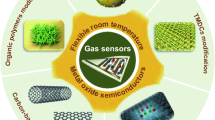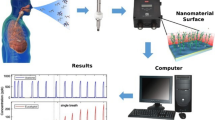Abstract
Polypyrrole exhibits reversible changes in their direct current resistance on exposure to organic volatiles. However, one needs to employ an array of such sensors to discriminate organic volatiles present in a mixture. Hence, polypyrrole based gas sensor is designed for the detection and discrimination of different organic volatiles. Multi frequency impedance measurement technique is used to detect the organic vapors, such as acetone, ethanol and Isopropyl alcohol, in the gas phase, over a frequency range 10 Hz to 2 MHz. The sensor response is monitored by measuring the changes in its capacitance, resistance and the dissipation factor upon exposure to organic volatiles. It is observed that the capacitive property of the sensor is more sensitive to these volatiles than its resistive property. Each volatile responds to the sensor in terms of dissipation factor at specific frequency and found that the peak magnitude has a linear relationship with their concentrations.








Similar content being viewed by others
References
Amrani MEH, Payne PA, Persaud KC (1995) Multi-frequency measurements of organic conducting polymers for sensing of gases and vapours. In: The 8th international conference on solid-state sensors and actuators and eurosensor IX, Stockholm, Sweden
Arafeh LMM (1992) Investigation of multi-element gas sensing systems. PhD Thesis, University of Manchester (UMIST)
Archer WI, Armstrong RD (1980) The application of a.c. impedance methods to solid electrolytes. Chem. Soc. Specialist Periodical Reports, chap 3, vol 7
Barratt RS (1981) The preparation of standard gas mixtures. Analyst 106:817–849
Bhatt Chintan M, Nagaraju J (2010) Studies on electrical properties of wheat bread as a function of moisture content during storage. J Sens Instrumen Food Qual 4:61–66
Buus RG (1970) Physical design of electronic systems. In: Everitt WL (ed) Design technology, vol I. NJ Prentice Hall, Englewood Cliffs, chap 9, pp 327–380
Josse F, Lukas R, Zhou R, Schneider S, Everhart D (1996) AC-impedance-based chemical sensors for organic solvent vapors. Sens Actuators B 35–36:363–369
Heilig A, Barsan N, Weimar U, Schweizer-Berberich M, GÖpel W (1997) Gas identification by modulating temperatures of SnO2, based thick film sensors. Sens Actuators B 43:45–51
Holdcraft S, Lionel Funt B (1988) Preparation and electrocatalytic properties of conducting films of polypyrrole containing platinum microparticulates. J Electroanal Chem 240(1–2):89–103
Hwang JH, Mason TO, Buehler MF, Datab JG, Matson DW, Linehan JC (1995) Characterization of humidity-sensing NiONi(OH) 2 nanocoreposites by impedance spectroscopy. Mater Sci Eng A 204:252–257
Katz M (1997) Methods of air sampling and analysis, 2nd edn. American Riblic Health Association, Byrd Pre-Press, Springfield
Macdonald R (1987) Impedance spectroscopy emphasizing solid materials and systems, chap 1–2. Wiley, New York
Magan N, Evans P (2000) Volatiles as an indicator of fungal activity and differentiation between species and the potential use of electronic nose technology for early detection of grain spoilage. J Stored Prod Res 36:319–340
Musio F, Amrani MEH, Persand KC (1995) High-frequency a.c. investigation of conducting polymer gas sensors. Sens Actuators B 23:223–226
Nakamoto Ide IT, Moriizumi T (1993) Development of odour-sensing system using an auto-sampling stage. Sens Actuators B Chem 13:351–354
Nakamoto T, Yosihioka M, Tanaka Y, Kobayashi K, Moriizumi T, Ueyama S, Yerazunis WS (2006) Colorimetric method for odor discrimination using dye-coated plate and multiLED sensor. Sens Actuators B 116:202–206
Payne PA, Persaud KC, Amrani MEH (1996) Novel techniques for interrogating conducting polymer gas sensors. In: 6th international meeting on chemical sensors, Gaithershurg
Shimada E, Tachibana K (1995) An interpretation on conductivity propagation in polyaniline based on impedance analysis. J Electrochem Soc 142:4078–4082
Valentine FHH, North AA (1980) Odour control: a concise guide. Warren Spring Laboratory, Department of Industry, UK, pp 17–29
Acknowledgments
The authors acknowledge the support of the Centre of Excellence in Nanoelectronics (CEN) at IISc., to carry out the above investigations.
Author information
Authors and Affiliations
Corresponding author
Rights and permissions
About this article
Cite this article
Bhatt, C.M., Jampana, N. Multi frequency interrogation of polypyrrole based gas sensors for organic vapors. Microsyst Technol 17, 417–423 (2011). https://doi.org/10.1007/s00542-011-1249-3
Received:
Accepted:
Published:
Issue Date:
DOI: https://doi.org/10.1007/s00542-011-1249-3




